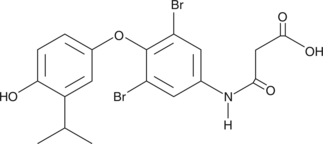Chemicals
Showing 23851–24000 of 41137 results
-
K22 is an antiviral agent.{59568} It inhibits the replication of severe acute respiratory syndrome coronavirus (SARS-CoV), Middle East respiratory syndrome coronavirus (MERS-CoV), human coronavirus 229E (HCoV-229E), feline coronavirus (FCoV), and mouse hepatitis virus (MHV) in Vero cells when used at a concentration of 40 µM. K22 inhibits the formation of double membrane vesicles, a hallmark of coronavirus replication, and inhibits viral RNA synthesis in HCoV-229E-infected MRC-5 cells. It also reduces viral titers in cells infected with various Arteriviridae or Torovirinae viruses.{59569}
Brand:CaymanSKU:31578 - 1 mgAvailable on backorder
K22 is an antiviral agent.{59568} It inhibits the replication of severe acute respiratory syndrome coronavirus (SARS-CoV), Middle East respiratory syndrome coronavirus (MERS-CoV), human coronavirus 229E (HCoV-229E), feline coronavirus (FCoV), and mouse hepatitis virus (MHV) in Vero cells when used at a concentration of 40 µM. K22 inhibits the formation of double membrane vesicles, a hallmark of coronavirus replication, and inhibits viral RNA synthesis in HCoV-229E-infected MRC-5 cells. It also reduces viral titers in cells infected with various Arteriviridae or Torovirinae viruses.{59569}
Brand:CaymanSKU:31578 - 10 mgAvailable on backorder
K22 is an antiviral agent.{59568} It inhibits the replication of severe acute respiratory syndrome coronavirus (SARS-CoV), Middle East respiratory syndrome coronavirus (MERS-CoV), human coronavirus 229E (HCoV-229E), feline coronavirus (FCoV), and mouse hepatitis virus (MHV) in Vero cells when used at a concentration of 40 µM. K22 inhibits the formation of double membrane vesicles, a hallmark of coronavirus replication, and inhibits viral RNA synthesis in HCoV-229E-infected MRC-5 cells. It also reduces viral titers in cells infected with various Arteriviridae or Torovirinae viruses.{59569}
Brand:CaymanSKU:31578 - 25 mgAvailable on backorder
K22 is an antiviral agent.{59568} It inhibits the replication of severe acute respiratory syndrome coronavirus (SARS-CoV), Middle East respiratory syndrome coronavirus (MERS-CoV), human coronavirus 229E (HCoV-229E), feline coronavirus (FCoV), and mouse hepatitis virus (MHV) in Vero cells when used at a concentration of 40 µM. K22 inhibits the formation of double membrane vesicles, a hallmark of coronavirus replication, and inhibits viral RNA synthesis in HCoV-229E-infected MRC-5 cells. It also reduces viral titers in cells infected with various Arteriviridae or Torovirinae viruses.{59569}
Brand:CaymanSKU:31578 - 5 mgAvailable on backorder
K252a is a staurosporine analog isolated from Nocardiopsis sp. soil fungi that inhibits protein kinase (PK) C, PKA, Ca2+/calmodulin-dependent kinase type II, and phosphorylase kinase with IC50 values of 470, 140, 270, and 1.7 nM, respectively.{21294,17276} Because it inhibits neurotrophin receptor tyrosine kinases, K252a at 100-500 nM has been used to suppress trophoblast proliferation and increase apoptosis associated with the disruption of mitochondrial functions in cultured choriocarcinoma cells.{21290} Recently, K252a has been shown to inhibit PRK1 (IC50 = 3.2 nM in vitro), a PKC-related kinase that phosphorylates histone H3 at threonine 11 and is involved in androgen-dependent gene expression.{21798}
Brand:CaymanSKU:11338 - 1 mgAvailable on backorder
K252a is a staurosporine analog isolated from Nocardiopsis sp. soil fungi that inhibits protein kinase (PK) C, PKA, Ca2+/calmodulin-dependent kinase type II, and phosphorylase kinase with IC50 values of 470, 140, 270, and 1.7 nM, respectively.{21294,17276} Because it inhibits neurotrophin receptor tyrosine kinases, K252a at 100-500 nM has been used to suppress trophoblast proliferation and increase apoptosis associated with the disruption of mitochondrial functions in cultured choriocarcinoma cells.{21290} Recently, K252a has been shown to inhibit PRK1 (IC50 = 3.2 nM in vitro), a PKC-related kinase that phosphorylates histone H3 at threonine 11 and is involved in androgen-dependent gene expression.{21798}
Brand:CaymanSKU:11338 - 5 mgAvailable on backorder
K252b is an indolocarbazole isolated from the actinomycete Nocardiopsis, first described as an inhibitor of protein kinase C.{21294} However, as this compound does not freely pass through the cell membrane, it is used to inhibit extracellular kinases (ectokinases) of cells in culture.{21291,21295} K252b inhibits receptor-mediated degranulation from basophil-like RBL-2H3 cells (IC50 = 0.5 μg/ml) and human basophils.{21292} This extracellular inhibitor is also used in comparison studies with the closely related, cell-permeable inhibitor K252a, particularly in studies of neuronal differentiation.{21293,21290}
Brand:CaymanSKU:11339 - 1 mgAvailable on backorder
K252b is an indolocarbazole isolated from the actinomycete Nocardiopsis, first described as an inhibitor of protein kinase C.{21294} However, as this compound does not freely pass through the cell membrane, it is used to inhibit extracellular kinases (ectokinases) of cells in culture.{21291,21295} K252b inhibits receptor-mediated degranulation from basophil-like RBL-2H3 cells (IC50 = 0.5 μg/ml) and human basophils.{21292} This extracellular inhibitor is also used in comparison studies with the closely related, cell-permeable inhibitor K252a, particularly in studies of neuronal differentiation.{21293,21290}
Brand:CaymanSKU:11339 - 500 µgAvailable on backorder
K252c is a cell-permeable PKC inhibitor (IC50s = 2.45 and 25.7 µM for PKC and PKA, respectively).{34152} It induces apoptosis in human chronic myelogenous leukemia cancer cells.{34151} In human foreskin fibroblast cells, it reduces focus formation induced by human cytomegalovirus (HCMV) strains sensitive and resistant to Ganciclovir (Item No. 13853) with IC50s of 0.32 and 0.17 µM for HCMV A6245 and HCMV-6, respectively.{34153} It also inhibits the non-kinase enzymes β-lactamase, chymotrypsin, and malate dehydrogenase with IC50s of 8, 10, and 8 µM, suggesting less kinase-selectivity than was originally described.{22472}
Brand:CaymanSKU:-K252c is a cell-permeable PKC inhibitor (IC50s = 2.45 and 25.7 µM for PKC and PKA, respectively).{34152} It induces apoptosis in human chronic myelogenous leukemia cancer cells.{34151} In human foreskin fibroblast cells, it reduces focus formation induced by human cytomegalovirus (HCMV) strains sensitive and resistant to Ganciclovir (Item No. 13853) with IC50s of 0.32 and 0.17 µM for HCMV A6245 and HCMV-6, respectively.{34153} It also inhibits the non-kinase enzymes β-lactamase, chymotrypsin, and malate dehydrogenase with IC50s of 8, 10, and 8 µM, suggesting less kinase-selectivity than was originally described.{22472}
Brand:CaymanSKU:-K252c is a cell-permeable PKC inhibitor (IC50s = 2.45 and 25.7 µM for PKC and PKA, respectively).{34152} It induces apoptosis in human chronic myelogenous leukemia cancer cells.{34151} In human foreskin fibroblast cells, it reduces focus formation induced by human cytomegalovirus (HCMV) strains sensitive and resistant to Ganciclovir (Item No. 13853) with IC50s of 0.32 and 0.17 µM for HCMV A6245 and HCMV-6, respectively.{34153} It also inhibits the non-kinase enzymes β-lactamase, chymotrypsin, and malate dehydrogenase with IC50s of 8, 10, and 8 µM, suggesting less kinase-selectivity than was originally described.{22472}
Brand:CaymanSKU:-K252d is an indolocarbazole alkaloid found in Nocardiopsis.{46391} It is a PKC inhibitor that inhibits PKC isolated from rat brain (IC50 = 350 nM). It also inhibits calcium- and calmodulin-dependent phosphodiesterase isolated from bovine heart (IC50 = 46.2 µM).
Brand:CaymanSKU:28469 - 1 mgAvailable on backorder
K858 is an inhibitor of kinesin spindle protein Eg5 (IC50 = 1.3 µM for Eg5 ATPase activity).{46342} It inhibits growth (GI50 = 0.98 µM), induces mitotic arrest (EC50 = 1.6 µM), and activates caspase-3 (EC50 = 1.6 µM) in HCT116 cells. It selectively induces mitotic cell death in HCT116 cells over non-cancerous ARPE-19 retinal pigment epithelial cells. K858-treated HCT116 cells that escape mitotic cell death undergo polyploidization and senescence. K858 reduces tumor growth in an A2780 ovarian cancer mouse xenograft model when administered at a dose of 150 mg/kg and increases the number of mitotic cells with monopolar spindles in tumor tissue.
Brand:CaymanSKU:22112 -Out of stock
K858 is an inhibitor of kinesin spindle protein Eg5 (IC50 = 1.3 µM for Eg5 ATPase activity).{46342} It inhibits growth (GI50 = 0.98 µM), induces mitotic arrest (EC50 = 1.6 µM), and activates caspase-3 (EC50 = 1.6 µM) in HCT116 cells. It selectively induces mitotic cell death in HCT116 cells over non-cancerous ARPE-19 retinal pigment epithelial cells. K858-treated HCT116 cells that escape mitotic cell death undergo polyploidization and senescence. K858 reduces tumor growth in an A2780 ovarian cancer mouse xenograft model when administered at a dose of 150 mg/kg and increases the number of mitotic cells with monopolar spindles in tumor tissue.
Brand:CaymanSKU:22112 -Out of stock
K858 is an inhibitor of kinesin spindle protein Eg5 (IC50 = 1.3 µM for Eg5 ATPase activity).{46342} It inhibits growth (GI50 = 0.98 µM), induces mitotic arrest (EC50 = 1.6 µM), and activates caspase-3 (EC50 = 1.6 µM) in HCT116 cells. It selectively induces mitotic cell death in HCT116 cells over non-cancerous ARPE-19 retinal pigment epithelial cells. K858-treated HCT116 cells that escape mitotic cell death undergo polyploidization and senescence. K858 reduces tumor growth in an A2780 ovarian cancer mouse xenograft model when administered at a dose of 150 mg/kg and increases the number of mitotic cells with monopolar spindles in tumor tissue.
Brand:CaymanSKU:22112 -Out of stock
K858 is an inhibitor of kinesin spindle protein Eg5 (IC50 = 1.3 µM for Eg5 ATPase activity).{46342} It inhibits growth (GI50 = 0.98 µM), induces mitotic arrest (EC50 = 1.6 µM), and activates caspase-3 (EC50 = 1.6 µM) in HCT116 cells. It selectively induces mitotic cell death in HCT116 cells over non-cancerous ARPE-19 retinal pigment epithelial cells. K858-treated HCT116 cells that escape mitotic cell death undergo polyploidization and senescence. K858 reduces tumor growth in an A2780 ovarian cancer mouse xenograft model when administered at a dose of 150 mg/kg and increases the number of mitotic cells with monopolar spindles in tumor tissue.
Brand:CaymanSKU:22112 -Out of stock
Kaempferide is a flavonoid that has been found in Alpinia and has diverse biological activities.{46690,46691,46692,46693} It scavenges 2,2-diphenyl-1-picrylhydrazyl (DPPH; Item No. 14805) radicals in a cell-free assay (IC50 = 97.58 μg/ml).{46690} Kaempferide is cytotoxic to HT-1080 and Colon 26-L5 cells (EC50s = 2.91 and 5.95 μg/ml, respectively) and decreases lipid accumulation in 3T3-L1 preadipocytes when used at a concentration of 50 μM.{46691,46692} It attenuates decreases in left ventricular systolic pressure (LVSP) and increases in left ventricular end-diastolic pressure (LVEDP) and reduces infarct size in a rat model of myocardial ischemia-reperfusion injury induced by coronary artery ligation when administered at doses of 0.3 and 1 mg/kg.{46693}
Brand:CaymanSKU:29673 - 10 mgAvailable on backorder
Kaempferide is a flavonoid that has been found in Alpinia and has diverse biological activities.{46690,46691,46692,46693} It scavenges 2,2-diphenyl-1-picrylhydrazyl (DPPH; Item No. 14805) radicals in a cell-free assay (IC50 = 97.58 μg/ml).{46690} Kaempferide is cytotoxic to HT-1080 and Colon 26-L5 cells (EC50s = 2.91 and 5.95 μg/ml, respectively) and decreases lipid accumulation in 3T3-L1 preadipocytes when used at a concentration of 50 μM.{46691,46692} It attenuates decreases in left ventricular systolic pressure (LVSP) and increases in left ventricular end-diastolic pressure (LVEDP) and reduces infarct size in a rat model of myocardial ischemia-reperfusion injury induced by coronary artery ligation when administered at doses of 0.3 and 1 mg/kg.{46693}
Brand:CaymanSKU:29673 - 25 mgAvailable on backorder
Kaempferide is a flavonoid that has been found in Alpinia and has diverse biological activities.{46690,46691,46692,46693} It scavenges 2,2-diphenyl-1-picrylhydrazyl (DPPH; Item No. 14805) radicals in a cell-free assay (IC50 = 97.58 μg/ml).{46690} Kaempferide is cytotoxic to HT-1080 and Colon 26-L5 cells (EC50s = 2.91 and 5.95 μg/ml, respectively) and decreases lipid accumulation in 3T3-L1 preadipocytes when used at a concentration of 50 μM.{46691,46692} It attenuates decreases in left ventricular systolic pressure (LVSP) and increases in left ventricular end-diastolic pressure (LVEDP) and reduces infarct size in a rat model of myocardial ischemia-reperfusion injury induced by coronary artery ligation when administered at doses of 0.3 and 1 mg/kg.{46693}
Brand:CaymanSKU:29673 - 5 mgAvailable on backorder
Kaempferide is a flavonoid that has been found in Alpinia and has diverse biological activities.{46690,46691,46692,46693} It scavenges 2,2-diphenyl-1-picrylhydrazyl (DPPH; Item No. 14805) radicals in a cell-free assay (IC50 = 97.58 μg/ml).{46690} Kaempferide is cytotoxic to HT-1080 and Colon 26-L5 cells (EC50s = 2.91 and 5.95 μg/ml, respectively) and decreases lipid accumulation in 3T3-L1 preadipocytes when used at a concentration of 50 μM.{46691,46692} It attenuates decreases in left ventricular systolic pressure (LVSP) and increases in left ventricular end-diastolic pressure (LVEDP) and reduces infarct size in a rat model of myocardial ischemia-reperfusion injury induced by coronary artery ligation when administered at doses of 0.3 and 1 mg/kg.{46693}
Brand:CaymanSKU:29673 - 50 mgAvailable on backorder
Kaempferitrin is a naturally-occurring kaempferol glycoside which can be isolated from the leaves of various plants used in traditional herbal medicine.{21664,21660,21659} Like many flavonols, it has antimicrobial, antioxidant, and anti-inflammatory activities.{21659,21664} For example, kaempferitrin inhibits LPS-induced nitric oxide production in mouse macrophages with an IC50 value of 40 μM.{21659} It also mimics insulin in stimulating glucose uptake in diabetic rats, but inhibits insulin-stimulated glucose uptake in 3T3-L1 cells.{21660,21662}
Brand:CaymanSKU:12093 - 1 mgAvailable on backorder
Kaempferitrin is a naturally-occurring kaempferol glycoside which can be isolated from the leaves of various plants used in traditional herbal medicine.{21664,21660,21659} Like many flavonols, it has antimicrobial, antioxidant, and anti-inflammatory activities.{21659,21664} For example, kaempferitrin inhibits LPS-induced nitric oxide production in mouse macrophages with an IC50 value of 40 μM.{21659} It also mimics insulin in stimulating glucose uptake in diabetic rats, but inhibits insulin-stimulated glucose uptake in 3T3-L1 cells.{21660,21662}
Brand:CaymanSKU:12093 - 5 mgAvailable on backorder
Kaempferol is a flavonoid which is abundant in a variety of plant leaves and fruits. It has diverse physiological activities through both direct and indirect effects.{21135,20648} For example, kaempferol directly binds estrogen receptors α and β, acting as an inverse agonist or agonist.{21134,21136} It also acts as an antioxidant, which presumably contributes to its ability to suppress advanced glycation endproduct-induced NADPH oxidase, NF-κB signaling, and hypoxia-inducible factor-related angiogenesis and VEGF expression.{21137,21139} Kaempferol also suppresses signaling through certain receptor tyrosine kinases, including EGFR and HGF.{16737,21138,20648}
Brand:CaymanSKU:11852 - 100 mgAvailable on backorder
Kaempferol is a flavonoid which is abundant in a variety of plant leaves and fruits. It has diverse physiological activities through both direct and indirect effects.{21135,20648} For example, kaempferol directly binds estrogen receptors α and β, acting as an inverse agonist or agonist.{21134,21136} It also acts as an antioxidant, which presumably contributes to its ability to suppress advanced glycation endproduct-induced NADPH oxidase, NF-κB signaling, and hypoxia-inducible factor-related angiogenesis and VEGF expression.{21137,21139} Kaempferol also suppresses signaling through certain receptor tyrosine kinases, including EGFR and HGF.{16737,21138,20648}
Brand:CaymanSKU:11852 - 25 mgAvailable on backorder
Kaempferol is a flavonoid which is abundant in a variety of plant leaves and fruits. It has diverse physiological activities through both direct and indirect effects.{21135,20648} For example, kaempferol directly binds estrogen receptors α and β, acting as an inverse agonist or agonist.{21134,21136} It also acts as an antioxidant, which presumably contributes to its ability to suppress advanced glycation endproduct-induced NADPH oxidase, NF-κB signaling, and hypoxia-inducible factor-related angiogenesis and VEGF expression.{21137,21139} Kaempferol also suppresses signaling through certain receptor tyrosine kinases, including EGFR and HGF.{16737,21138,20648}
Brand:CaymanSKU:11852 - 50 mgAvailable on backorder
Kaempferol-3-glucoside is an orally bioavailable flavonoid that has been isolated from the leaves of D. kaki and R. agrestis and has anti-inflammatory activity.{41843,41845} Kaempferol-3-glucoside (20-80 µg/ml) dose-dependently inhibits IL-1β-stimulated nitric oxide and prostaglandin E2 (PGE2; Item No. 14010) production in patient-derived osteoarthritis chondrocytes, an effect that is blocked by the PPAR-γ inhibitor GW 9662 (Item No. 70785).{41845} It also inhibits IL-1β-stimulated expression of nitric oxide synthase (NOS) and COX-2 and activation of MAPK and NF-κB signaling. Kaempferol-3-glucoside (1-20 µM) dose-dependently prevents the loss of E-cadherin, expression of vimentin, and production of collagen type-1 in hydrogen peroxide-exposed human bronchial epithelial cells in vitro.{41844} Kaempferol-3-glucoside (1.5 mg/kg, p.o.) inhibits ear swelling and the production of IL-2 and IL-4 as well as reduces serum IgE levels in a mouse model of atopic dermatitis.{41843} Kaempferol-3-glucoside (10-20 mg/kg, p.o.) also reduces reactive oxygen species (ROS) production, collagen fiber deposition, and autophagosome formation in the epithelial lung tissue of ovalbumin-challenged mice.{41844}
Brand:CaymanSKU:25060 - 10 mgAvailable on backorder
Kaempferol-3-glucoside is an orally bioavailable flavonoid that has been isolated from the leaves of D. kaki and R. agrestis and has anti-inflammatory activity.{41843,41845} Kaempferol-3-glucoside (20-80 µg/ml) dose-dependently inhibits IL-1β-stimulated nitric oxide and prostaglandin E2 (PGE2; Item No. 14010) production in patient-derived osteoarthritis chondrocytes, an effect that is blocked by the PPAR-γ inhibitor GW 9662 (Item No. 70785).{41845} It also inhibits IL-1β-stimulated expression of nitric oxide synthase (NOS) and COX-2 and activation of MAPK and NF-κB signaling. Kaempferol-3-glucoside (1-20 µM) dose-dependently prevents the loss of E-cadherin, expression of vimentin, and production of collagen type-1 in hydrogen peroxide-exposed human bronchial epithelial cells in vitro.{41844} Kaempferol-3-glucoside (1.5 mg/kg, p.o.) inhibits ear swelling and the production of IL-2 and IL-4 as well as reduces serum IgE levels in a mouse model of atopic dermatitis.{41843} Kaempferol-3-glucoside (10-20 mg/kg, p.o.) also reduces reactive oxygen species (ROS) production, collagen fiber deposition, and autophagosome formation in the epithelial lung tissue of ovalbumin-challenged mice.{41844}
Brand:CaymanSKU:25060 - 25 mgAvailable on backorder
Kaempferol-3-glucoside is an orally bioavailable flavonoid that has been isolated from the leaves of D. kaki and R. agrestis and has anti-inflammatory activity.{41843,41845} Kaempferol-3-glucoside (20-80 µg/ml) dose-dependently inhibits IL-1β-stimulated nitric oxide and prostaglandin E2 (PGE2; Item No. 14010) production in patient-derived osteoarthritis chondrocytes, an effect that is blocked by the PPAR-γ inhibitor GW 9662 (Item No. 70785).{41845} It also inhibits IL-1β-stimulated expression of nitric oxide synthase (NOS) and COX-2 and activation of MAPK and NF-κB signaling. Kaempferol-3-glucoside (1-20 µM) dose-dependently prevents the loss of E-cadherin, expression of vimentin, and production of collagen type-1 in hydrogen peroxide-exposed human bronchial epithelial cells in vitro.{41844} Kaempferol-3-glucoside (1.5 mg/kg, p.o.) inhibits ear swelling and the production of IL-2 and IL-4 as well as reduces serum IgE levels in a mouse model of atopic dermatitis.{41843} Kaempferol-3-glucoside (10-20 mg/kg, p.o.) also reduces reactive oxygen species (ROS) production, collagen fiber deposition, and autophagosome formation in the epithelial lung tissue of ovalbumin-challenged mice.{41844}
Brand:CaymanSKU:25060 - 5 mgAvailable on backorder
Kaempferol-3-glucoside is an orally bioavailable flavonoid that has been isolated from the leaves of D. kaki and R. agrestis and has anti-inflammatory activity.{41843,41845} Kaempferol-3-glucoside (20-80 µg/ml) dose-dependently inhibits IL-1β-stimulated nitric oxide and prostaglandin E2 (PGE2; Item No. 14010) production in patient-derived osteoarthritis chondrocytes, an effect that is blocked by the PPAR-γ inhibitor GW 9662 (Item No. 70785).{41845} It also inhibits IL-1β-stimulated expression of nitric oxide synthase (NOS) and COX-2 and activation of MAPK and NF-κB signaling. Kaempferol-3-glucoside (1-20 µM) dose-dependently prevents the loss of E-cadherin, expression of vimentin, and production of collagen type-1 in hydrogen peroxide-exposed human bronchial epithelial cells in vitro.{41844} Kaempferol-3-glucoside (1.5 mg/kg, p.o.) inhibits ear swelling and the production of IL-2 and IL-4 as well as reduces serum IgE levels in a mouse model of atopic dermatitis.{41843} Kaempferol-3-glucoside (10-20 mg/kg, p.o.) also reduces reactive oxygen species (ROS) production, collagen fiber deposition, and autophagosome formation in the epithelial lung tissue of ovalbumin-challenged mice.{41844}
Brand:CaymanSKU:25060 - 50 mgAvailable on backorder
Kahweol is a natural diterpene that is isolated from coffee beans.{21876} It increases glutathione S-transferase activity in the gut mucosa of mice and, with the diterpene cafestol, induces glutathione S-transferase expression in rat livers.{21876,21874} Kahweol has anti-inflammatory effects in RAW macrophages, inhibiting LPS-induced nitric oxide and prostaglandin E2 production (IC50 = 54 and 23 μM, respectively).{21878} Kahweol also is antiangiogenic, blocking the proliferation of endothelial cells (IC50 = 50 μM) and inhibiting endothelial migration, invasion, and tube formation.{21873} Kahweol is easily oxidized in the presence of air.{21876}
Brand:CaymanSKU:-Kahweol is a natural diterpene that is isolated from coffee beans.{21876} It increases glutathione S-transferase activity in the gut mucosa of mice and, with the diterpene cafestol, induces glutathione S-transferase expression in rat livers.{21876,21874} Kahweol has anti-inflammatory effects in RAW macrophages, inhibiting LPS-induced nitric oxide and prostaglandin E2 production (IC50 = 54 and 23 μM, respectively).{21878} Kahweol also is antiangiogenic, blocking the proliferation of endothelial cells (IC50 = 50 μM) and inhibiting endothelial migration, invasion, and tube formation.{21873} Kahweol is easily oxidized in the presence of air.{21876}
Brand:CaymanSKU:-Kahweol is a natural diterpene that is isolated from coffee beans.{21876} It increases glutathione S-transferase activity in the gut mucosa of mice and, with the diterpene cafestol, induces glutathione S-transferase expression in rat livers.{21876,21874} Kahweol has anti-inflammatory effects in RAW macrophages, inhibiting LPS-induced nitric oxide and prostaglandin E2 production (IC50 = 54 and 23 μM, respectively).{21878} Kahweol also is antiangiogenic, blocking the proliferation of endothelial cells (IC50 = 50 μM) and inhibiting endothelial migration, invasion, and tube formation.{21873} Kahweol is easily oxidized in the presence of air.{21876}
Brand:CaymanSKU:-Kanamycin A is a broad spectrum antibiotic isolated from a soil streptomyces (S. kanamyceticus). This aminoglycoside alters translation by prokaryotic ribosomes, resulting in bacterial cell death.{25037} In molecular biology, kanamycin A is used as a selective agent to isolate transformants that are expressing a kanamycin resistance gene, usually neomycin phosphotransferase (NptII/neo). This mode of selection is most commonly used in plant and mammalian biology.
Brand:CaymanSKU:-Kanamycin A is a broad spectrum antibiotic isolated from a soil streptomyces (S. kanamyceticus). This aminoglycoside alters translation by prokaryotic ribosomes, resulting in bacterial cell death.{25037} In molecular biology, kanamycin A is used as a selective agent to isolate transformants that are expressing a kanamycin resistance gene, usually neomycin phosphotransferase (NptII/neo). This mode of selection is most commonly used in plant and mammalian biology.
Brand:CaymanSKU:-Kanamycin A is a broad spectrum antibiotic isolated from a soil streptomyces (S. kanamyceticus). This aminoglycoside alters translation by prokaryotic ribosomes, resulting in bacterial cell death.{25037} In molecular biology, kanamycin A is used as a selective agent to isolate transformants that are expressing a kanamycin resistance gene, usually neomycin phosphotransferase (NptII/neo). This mode of selection is most commonly used in plant and mammalian biology.
Brand:CaymanSKU:-Kanosamine, a constituent of kanamycin, is an antibiotic produced by Streptomyces and Bacillus that can inhibit cell wall synthesis in plant-pathogenic oomycetes (MIC = 25 µg/ml for P. medicaginis M2913) and certain fungi as well as some bacterial species (MIC = 400 µg/ml for S. aureus).{27255,27256} It has been explored as an alternative and/or supplement to synthetic pesticides and genetic resistance of crop plants for the management of plant disease.{27255,27256}
Brand:CaymanSKU:-Out of stock
Kanosamine, a constituent of kanamycin, is an antibiotic produced by Streptomyces and Bacillus that can inhibit cell wall synthesis in plant-pathogenic oomycetes (MIC = 25 µg/ml for P. medicaginis M2913) and certain fungi as well as some bacterial species (MIC = 400 µg/ml for S. aureus).{27255,27256} It has been explored as an alternative and/or supplement to synthetic pesticides and genetic resistance of crop plants for the management of plant disease.{27255,27256}
Brand:CaymanSKU:-Out of stock
Kanosamine, a constituent of kanamycin, is an antibiotic produced by Streptomyces and Bacillus that can inhibit cell wall synthesis in plant-pathogenic oomycetes (MIC = 25 µg/ml for P. medicaginis M2913) and certain fungi as well as some bacterial species (MIC = 400 µg/ml for S. aureus).{27255,27256} It has been explored as an alternative and/or supplement to synthetic pesticides and genetic resistance of crop plants for the management of plant disease.{27255,27256}
Brand:CaymanSKU:-Out of stock
Kanosamine, a constituent of kanamycin, is an antibiotic produced by Streptomyces and Bacillus that can inhibit cell wall synthesis in plant-pathogenic oomycetes (MIC = 25 µg/ml for P. medicaginis M2913) and certain fungi as well as some bacterial species (MIC = 400 µg/ml for S. aureus).{27255,27256} It has been explored as an alternative and/or supplement to synthetic pesticides and genetic resistance of crop plants for the management of plant disease.{27255,27256}
Brand:CaymanSKU:-Out of stock
Biotin is a growth factor that plays an important role in numerous reactions that are critical to microorganisms, plants, and animals. Biotin has a strong affinity for the protein avidin, a trait that has been utilized for many assay reporter applications. KAPA is a key intermediate in the biotin biosynthetic pathway.{14860}
Brand:CaymanSKU:10007542 - 1 mgAvailable on backorder
Biotin is a growth factor that plays an important role in numerous reactions that are critical to microorganisms, plants, and animals. Biotin has a strong affinity for the protein avidin, a trait that has been utilized for many assay reporter applications. KAPA is a key intermediate in the biotin biosynthetic pathway.{14860}
Brand:CaymanSKU:10007542 - 10 mgAvailable on backorder
Biotin is a growth factor that plays an important role in numerous reactions that are critical to microorganisms, plants, and animals. Biotin has a strong affinity for the protein avidin, a trait that has been utilized for many assay reporter applications. KAPA is a key intermediate in the biotin biosynthetic pathway.{14860}
Brand:CaymanSKU:10007542 - 5 mgAvailable on backorder
Biotin is a growth factor that plays an important role in numerous reactions that are critical to microorganisms, plants, and animals. Biotin has a strong affinity for the protein avidin, a trait that has been utilized for many assay reporter applications. KAPA is a key intermediate in the biotin biosynthetic pathway.{14860}
Brand:CaymanSKU:10007542 - 50 mgAvailable on backorder
Karrikin 2 is a seed germination stimulant that has been found in plant-derived smoke.{52292,52293} It induces germination of A. thaliana, L. sativa, E. penduliflora, and S. orbiculatum seeds in a concentration-dependent manner.{52292,52294} Karrikin 2 (1 μM) increases expression of the gibberellin (GA) biosynthesis genes GA3ox1 and GA3ox2 and the GA4-responsive gene CP1 in A. thaliana seeds.{52292}
Brand:CaymanSKU:29822 - 1 mgAvailable on backorder
Karrikinolide is a plant growth regulator that has been found in plant-derived smoke.{53472} It increases the germination rate and seedling mass in a panel of eight arable weed species when applied to filter paper at a concentration of 1 µM. Topical application of karrikinolide (0.1 nM) increases the number of leaves, leaf length, and fresh and dry leaf weights in commercial onion (A. cepa) plants.{53471}
Brand:CaymanSKU:29935 - 1 mgAvailable on backorder
Kartogenin potently induces differentiation of human mesenchymal stem cells into chondrocytes with an EC50 value of 100 nM.{20986} Kartogenin induces chondrogenesis by binding the actin-binding protein, filamin A, which disrupts its interaction with the transcription factor core-binding factor β subunit (CBFβ). When dissociated from filamin A, CBFβ translocates to the nucleus and forms a transcriptional complex with the runt-related transcription factor RUNX1, which enables chondrocyte differentiation. Kartogenin has been shown to promote cartilage repair in a mouse model of osteoarthritis and to protect against cytokine-induced damage in osteoarthritic bovine articular chondrocytes in vitro.{20986}
Brand:CaymanSKU:11826 - 10 mgAvailable on backorder
Kartogenin potently induces differentiation of human mesenchymal stem cells into chondrocytes with an EC50 value of 100 nM.{20986} Kartogenin induces chondrogenesis by binding the actin-binding protein, filamin A, which disrupts its interaction with the transcription factor core-binding factor β subunit (CBFβ). When dissociated from filamin A, CBFβ translocates to the nucleus and forms a transcriptional complex with the runt-related transcription factor RUNX1, which enables chondrocyte differentiation. Kartogenin has been shown to promote cartilage repair in a mouse model of osteoarthritis and to protect against cytokine-induced damage in osteoarthritic bovine articular chondrocytes in vitro.{20986}
Brand:CaymanSKU:11826 - 25 mgAvailable on backorder
Kartogenin potently induces differentiation of human mesenchymal stem cells into chondrocytes with an EC50 value of 100 nM.{20986} Kartogenin induces chondrogenesis by binding the actin-binding protein, filamin A, which disrupts its interaction with the transcription factor core-binding factor β subunit (CBFβ). When dissociated from filamin A, CBFβ translocates to the nucleus and forms a transcriptional complex with the runt-related transcription factor RUNX1, which enables chondrocyte differentiation. Kartogenin has been shown to promote cartilage repair in a mouse model of osteoarthritis and to protect against cytokine-induced damage in osteoarthritic bovine articular chondrocytes in vitro.{20986}
Brand:CaymanSKU:11826 - 5 mgAvailable on backorder
Kasugamycin is an aminoglycosidic antibiotic isolated from S. kasugaensis. It blocks the initiation of translation, preventing initiation complex formation on 30S ribosomes in bacteria.{25036}
Brand:CaymanSKU:-Kasugamycin is an aminoglycosidic antibiotic isolated from S. kasugaensis. It blocks the initiation of translation, preventing initiation complex formation on 30S ribosomes in bacteria.{25036}
Brand:CaymanSKU:-Kasugamycin is an aminoglycosidic antibiotic isolated from S. kasugaensis. It blocks the initiation of translation, preventing initiation complex formation on 30S ribosomes in bacteria.{25036}
Brand:CaymanSKU:-Kaurenoic acid is a diterpene that has been found in C. langsdorffii and has diverse biological activities, including anticancer, antibacterial, antioxidant, and anti-inflammatory properties.{48636,48637,48638} It is cytotoxic to 22Rv1 and LNCaP prostate, HT-29, HCT116, SW480, and SW620 colon, and MCF-7 breast cancer cells with IC50 values ranging from 15.03 to 48.87 μg/ml.{48637} Kaurenoic acid is active against S. epidermidis, S. capitis, E. faecalis, and S. haemolyticus in vitro (MICs = 6.25-12.5 μg/ml).{48638} Kaurenoic acid (50 and 100 mg/kg) reduces colonic myeloperoxidase (MPO) activity and malondialdehyde (MDA) levels in a rat model of acetic acid-induced colitis, as well as colonic tissue damage, leukocytic infiltration, and submucosal edema when administered at a dose of 100 mg/kg.{48636}
Brand:CaymanSKU:28957 - 1 mgAvailable on backorder
Kaurenoic acid is a diterpene that has been found in C. langsdorffii and has diverse biological activities, including anticancer, antibacterial, antioxidant, and anti-inflammatory properties.{48636,48637,48638} It is cytotoxic to 22Rv1 and LNCaP prostate, HT-29, HCT116, SW480, and SW620 colon, and MCF-7 breast cancer cells with IC50 values ranging from 15.03 to 48.87 μg/ml.{48637} Kaurenoic acid is active against S. epidermidis, S. capitis, E. faecalis, and S. haemolyticus in vitro (MICs = 6.25-12.5 μg/ml).{48638} Kaurenoic acid (50 and 100 mg/kg) reduces colonic myeloperoxidase (MPO) activity and malondialdehyde (MDA) levels in a rat model of acetic acid-induced colitis, as well as colonic tissue damage, leukocytic infiltration, and submucosal edema when administered at a dose of 100 mg/kg.{48636}
Brand:CaymanSKU:28957 - 10 mgAvailable on backorder
Kaurenoic acid is a diterpene that has been found in C. langsdorffii and has diverse biological activities, including anticancer, antibacterial, antioxidant, and anti-inflammatory properties.{48636,48637,48638} It is cytotoxic to 22Rv1 and LNCaP prostate, HT-29, HCT116, SW480, and SW620 colon, and MCF-7 breast cancer cells with IC50 values ranging from 15.03 to 48.87 μg/ml.{48637} Kaurenoic acid is active against S. epidermidis, S. capitis, E. faecalis, and S. haemolyticus in vitro (MICs = 6.25-12.5 μg/ml).{48638} Kaurenoic acid (50 and 100 mg/kg) reduces colonic myeloperoxidase (MPO) activity and malondialdehyde (MDA) levels in a rat model of acetic acid-induced colitis, as well as colonic tissue damage, leukocytic infiltration, and submucosal edema when administered at a dose of 100 mg/kg.{48636}
Brand:CaymanSKU:28957 - 25 mgAvailable on backorder
Kaurenoic acid is a diterpene that has been found in C. langsdorffii and has diverse biological activities, including anticancer, antibacterial, antioxidant, and anti-inflammatory properties.{48636,48637,48638} It is cytotoxic to 22Rv1 and LNCaP prostate, HT-29, HCT116, SW480, and SW620 colon, and MCF-7 breast cancer cells with IC50 values ranging from 15.03 to 48.87 μg/ml.{48637} Kaurenoic acid is active against S. epidermidis, S. capitis, E. faecalis, and S. haemolyticus in vitro (MICs = 6.25-12.5 μg/ml).{48638} Kaurenoic acid (50 and 100 mg/kg) reduces colonic myeloperoxidase (MPO) activity and malondialdehyde (MDA) levels in a rat model of acetic acid-induced colitis, as well as colonic tissue damage, leukocytic infiltration, and submucosal edema when administered at a dose of 100 mg/kg.{48636}
Brand:CaymanSKU:28957 - 5 mgAvailable on backorder
Kavain is a kavalactone and the major constituent of the pepper plant kava (P. methysticum) and has diverse biological activities.{46119,46120,46121,46122} It is a positive allosteric modulator of α4β2δ subunit-containing GABAA receptors with EC50 values of 25 and 59 µM in the presence and absence of 300 µM kavain, respectively, in Xenopus oocytes expressing human receptors.{46119} Kavain reduces growth of WPMY-1 prostate cancer cells (IC50 = 5.2 µg/ml).{46120} It reduces LPS-induced TNF-α production in primary murine macrophages in a concentration-dependent manner.{46121} In vivo, kavain (1 mg/animal) reduces hind paw swelling and TNF-α production in wild-type, but not Erk-/-, mice in a mouse model of collagen-induced arthritis. Kavain also reduces acetic acid-induced abdominal constrictions in mice (ED50= 15.71 mg/kg).{46122}
Brand:CaymanSKU:26524 - 10 mgAvailable on backorder
Kavain is a kavalactone and the major constituent of the pepper plant kava (P. methysticum) and has diverse biological activities.{46119,46120,46121,46122} It is a positive allosteric modulator of α4β2δ subunit-containing GABAA receptors with EC50 values of 25 and 59 µM in the presence and absence of 300 µM kavain, respectively, in Xenopus oocytes expressing human receptors.{46119} Kavain reduces growth of WPMY-1 prostate cancer cells (IC50 = 5.2 µg/ml).{46120} It reduces LPS-induced TNF-α production in primary murine macrophages in a concentration-dependent manner.{46121} In vivo, kavain (1 mg/animal) reduces hind paw swelling and TNF-α production in wild-type, but not Erk-/-, mice in a mouse model of collagen-induced arthritis. Kavain also reduces acetic acid-induced abdominal constrictions in mice (ED50= 15.71 mg/kg).{46122}
Brand:CaymanSKU:26524 - 100 mgAvailable on backorder
Kavain is a kavalactone and the major constituent of the pepper plant kava (P. methysticum) and has diverse biological activities.{46119,46120,46121,46122} It is a positive allosteric modulator of α4β2δ subunit-containing GABAA receptors with EC50 values of 25 and 59 µM in the presence and absence of 300 µM kavain, respectively, in Xenopus oocytes expressing human receptors.{46119} Kavain reduces growth of WPMY-1 prostate cancer cells (IC50 = 5.2 µg/ml).{46120} It reduces LPS-induced TNF-α production in primary murine macrophages in a concentration-dependent manner.{46121} In vivo, kavain (1 mg/animal) reduces hind paw swelling and TNF-α production in wild-type, but not Erk-/-, mice in a mouse model of collagen-induced arthritis. Kavain also reduces acetic acid-induced abdominal constrictions in mice (ED50= 15.71 mg/kg).{46122}
Brand:CaymanSKU:26524 - 50 mgAvailable on backorder
Kazusamycin A is an antibiotic from Streptomyces and a hydroxy analog of Leptomycin B (Item No. 10004976) that demonstrates cytotoxic activity against various human and mouse tumor lines.{31688} Additionally, at nanomolar concentrations, it inhibits nuclear export and translocation of Rev, a regulatory gene product in the HIV genome.{31689,31690}
Brand:CaymanSKU:20137 -Available on backorder
Kazusamycin A is an antibiotic from Streptomyces and a hydroxy analog of Leptomycin B (Item No. 10004976) that demonstrates cytotoxic activity against various human and mouse tumor lines.{31688} Additionally, at nanomolar concentrations, it inhibits nuclear export and translocation of Rev, a regulatory gene product in the HIV genome.{31689,31690}
Brand:CaymanSKU:20137 -Available on backorder
Kazusamycin B is a bacterial metabolite originally isolated from Streptomyces.{47374} It has antifungal activity against S. pombe and R. javanicus (MICs = 0.05 and 2.13 µg/ml, respectively) but is inactive against Gram-positive and Gram-negative bacteria (MICs = >100 µg/ml). Kazusamycin B (5 ng/ml) halts the cell cycle at the G1 phase and induces nuclear condensation in L1210 cells, as well as inhibits nuclear-to-cytosolic transport of the HIV-1 regulatory protein Rev in HeLa cells expressing Rev (IC50 = 6.3 nM).{47375,31690} It is cytotoxic to L1210 and HCT-8 cells with IC50 values of 1.8 and 1.6 ng/ml, respectively, and reduces tumor growth in a variety of murine tumor and mouse xenograft models.{47376}
Brand:CaymanSKU:28119 - 100 µgAvailable on backorder
Kazusamycin B is a bacterial metabolite originally isolated from Streptomyces.{47374} It has antifungal activity against S. pombe and R. javanicus (MICs = 0.05 and 2.13 µg/ml, respectively) but is inactive against Gram-positive and Gram-negative bacteria (MICs = >100 µg/ml). Kazusamycin B (5 ng/ml) halts the cell cycle at the G1 phase and induces nuclear condensation in L1210 cells, as well as inhibits nuclear-to-cytosolic transport of the HIV-1 regulatory protein Rev in HeLa cells expressing Rev (IC50 = 6.3 nM).{47375,31690} It is cytotoxic to L1210 and HCT-8 cells with IC50 values of 1.8 and 1.6 ng/ml, respectively, and reduces tumor growth in a variety of murine tumor and mouse xenograft models.{47376}
Brand:CaymanSKU:28119 - 500 µgAvailable on backorder
kb NB 142-70 is a selective inhibitor of protein kinase D (PKD) with IC50 values of 28.3, 58.7, and 53.2 nM for PKD1, 2, and 3, respectively.{32618} It has been shown to inhibit prostate cancer cell migration and invasion, as well as reduce wound healing in vitro.{32618,32619}
Brand:CaymanSKU:-Available on backorder
kb NB 142-70 is a selective inhibitor of protein kinase D (PKD) with IC50 values of 28.3, 58.7, and 53.2 nM for PKD1, 2, and 3, respectively.{32618} It has been shown to inhibit prostate cancer cell migration and invasion, as well as reduce wound healing in vitro.{32618,32619}
Brand:CaymanSKU:-Available on backorder
kb NB 142-70 is a selective inhibitor of protein kinase D (PKD) with IC50 values of 28.3, 58.7, and 53.2 nM for PKD1, 2, and 3, respectively.{32618} It has been shown to inhibit prostate cancer cell migration and invasion, as well as reduce wound healing in vitro.{32618,32619}
Brand:CaymanSKU:-Available on backorder
kb NB 142-70 is a selective inhibitor of protein kinase D (PKD) with IC50 values of 28.3, 58.7, and 53.2 nM for PKD1, 2, and 3, respectively.{32618} It has been shown to inhibit prostate cancer cell migration and invasion, as well as reduce wound healing in vitro.{32618,32619}
Brand:CaymanSKU:-Available on backorder
kb-NB77-78 is an inactive analog of the protein kinase D (PKD) inhibitor CID755673 (Item No. 15924).{53005} It does not bind PKD1 in a fluorescence polarization assay and has no effect on PKD1 phosphorylation in LNCaP cancer cells.
Brand:CaymanSKU:21562 -Out of stock
kb-NB77-78 is an inactive analog of the protein kinase D (PKD) inhibitor CID755673 (Item No. 15924).{53005} It does not bind PKD1 in a fluorescence polarization assay and has no effect on PKD1 phosphorylation in LNCaP cancer cells.
Brand:CaymanSKU:21562 -Out of stock
kb-NB77-78 is an inactive analog of the protein kinase D (PKD) inhibitor CID755673 (Item No. 15924).{53005} It does not bind PKD1 in a fluorescence polarization assay and has no effect on PKD1 phosphorylation in LNCaP cancer cells.
Brand:CaymanSKU:21562 -Out of stock
kb-NB77-78 is an inactive analog of the protein kinase D (PKD) inhibitor CID755673 (Item No. 15924).{53005} It does not bind PKD1 in a fluorescence polarization assay and has no effect on PKD1 phosphorylation in LNCaP cancer cells.
Brand:CaymanSKU:21562 -Out of stock
The Na+/Ca2+ exchanger (NCX) is a major regulator of intracellular calcium concentration that is largely expressed in cardiac sarcolemma (NCX1) but also in brain and skeletal muscle (NCX2). KB-R7943 is an isothiourea derivative that selectively inhibits the reverse mode of NCX1 (IC50 = 1.2-2.4 µM), preventing intracellular sodium-dependent calcium uptake in whole cells.{26636} It is much less potent at preventing extracellular sodium-dependent calcium efflux from intact cells (IC50 > 30 µM).{26636} In cultured hippocampal neurons, KB-R7943 exhibits neuroprotection from glutamate-induced excitotoxicity by blocking NMDA receptor-mediated activity (IC50 = 13.4 µM) and inhibiting complex I in the mitochondrial respiratory chain (IC50 = 11.4 µM).{26637} KB-R7943 has also been shown to block transient receptor potential canonical channels, which are important mediators of calcium-dependent signal transduction.{26638}
Brand:CaymanSKU:-Out of stock
The Na+/Ca2+ exchanger (NCX) is a major regulator of intracellular calcium concentration that is largely expressed in cardiac sarcolemma (NCX1) but also in brain and skeletal muscle (NCX2). KB-R7943 is an isothiourea derivative that selectively inhibits the reverse mode of NCX1 (IC50 = 1.2-2.4 µM), preventing intracellular sodium-dependent calcium uptake in whole cells.{26636} It is much less potent at preventing extracellular sodium-dependent calcium efflux from intact cells (IC50 > 30 µM).{26636} In cultured hippocampal neurons, KB-R7943 exhibits neuroprotection from glutamate-induced excitotoxicity by blocking NMDA receptor-mediated activity (IC50 = 13.4 µM) and inhibiting complex I in the mitochondrial respiratory chain (IC50 = 11.4 µM).{26637} KB-R7943 has also been shown to block transient receptor potential canonical channels, which are important mediators of calcium-dependent signal transduction.{26638}
Brand:CaymanSKU:-Out of stock
The Na+/Ca2+ exchanger (NCX) is a major regulator of intracellular calcium concentration that is largely expressed in cardiac sarcolemma (NCX1) but also in brain and skeletal muscle (NCX2). KB-R7943 is an isothiourea derivative that selectively inhibits the reverse mode of NCX1 (IC50 = 1.2-2.4 µM), preventing intracellular sodium-dependent calcium uptake in whole cells.{26636} It is much less potent at preventing extracellular sodium-dependent calcium efflux from intact cells (IC50 > 30 µM).{26636} In cultured hippocampal neurons, KB-R7943 exhibits neuroprotection from glutamate-induced excitotoxicity by blocking NMDA receptor-mediated activity (IC50 = 13.4 µM) and inhibiting complex I in the mitochondrial respiratory chain (IC50 = 11.4 µM).{26637} KB-R7943 has also been shown to block transient receptor potential canonical channels, which are important mediators of calcium-dependent signal transduction.{26638}
Brand:CaymanSKU:-Out of stock
The thyroid hormones, thyroxine (T4) and triiodothyronine (T3), promote the reduction of plasma cholesterol levels and induce weight loss. However when administered in high doses, thyroid hormones produce undesirable side effects in the heart, bone and muscle. KB2115 is a synthetic thyroid hormone mimetic. At a dose of 50-200 µg administered to humans once-daily for 14 days, KB2115 lowers total and low-density lipoprotein cholesterol up to 40% without affecting high-density lipoprotein cholesterol levels and without deleterious side effects to the cardiovascular system.{15145} Unlike the statin class of drugs which decrease cholesterol synthesis, KB2115 stimulates cholesterol catabolism to bile acids without affecting cholesterol synthesis.{15145}
Brand:CaymanSKU:10011054 - 1 mgAvailable on backorder
The thyroid hormones, thyroxine (T4) and triiodothyronine (T3), promote the reduction of plasma cholesterol levels and induce weight loss. However when administered in high doses, thyroid hormones produce undesirable side effects in the heart, bone and muscle. KB2115 is a synthetic thyroid hormone mimetic. At a dose of 50-200 µg administered to humans once-daily for 14 days, KB2115 lowers total and low-density lipoprotein cholesterol up to 40% without affecting high-density lipoprotein cholesterol levels and without deleterious side effects to the cardiovascular system.{15145} Unlike the statin class of drugs which decrease cholesterol synthesis, KB2115 stimulates cholesterol catabolism to bile acids without affecting cholesterol synthesis.{15145}
Brand:CaymanSKU:10011054 - 10 mgAvailable on backorder
The thyroid hormones, thyroxine (T4) and triiodothyronine (T3), promote the reduction of plasma cholesterol levels and induce weight loss. However when administered in high doses, thyroid hormones produce undesirable side effects in the heart, bone and muscle. KB2115 is a synthetic thyroid hormone mimetic. At a dose of 50-200 µg administered to humans once-daily for 14 days, KB2115 lowers total and low-density lipoprotein cholesterol up to 40% without affecting high-density lipoprotein cholesterol levels and without deleterious side effects to the cardiovascular system.{15145} Unlike the statin class of drugs which decrease cholesterol synthesis, KB2115 stimulates cholesterol catabolism to bile acids without affecting cholesterol synthesis.{15145}
Brand:CaymanSKU:10011054 - 5 mgAvailable on backorder
The thyroid hormones, thyroxine (T4) and triiodothyronine (T3), promote the reduction of plasma cholesterol levels and induce weight loss. However when administered in high doses, thyroid hormones produce undesirable side effects in the heart, bone and muscle. KB2115 is a synthetic thyroid hormone mimetic. At a dose of 50-200 µg administered to humans once-daily for 14 days, KB2115 lowers total and low-density lipoprotein cholesterol up to 40% without affecting high-density lipoprotein cholesterol levels and without deleterious side effects to the cardiovascular system.{15145} Unlike the statin class of drugs which decrease cholesterol synthesis, KB2115 stimulates cholesterol catabolism to bile acids without affecting cholesterol synthesis.{15145}
Brand:CaymanSKU:10011054 - 500 µgAvailable on backorder
KBC-007 is a synthetic branched chain-containing analog of α-galactosylceramide (α-GalCer).{46100,46099} It induces IL-4 and IFN-γ secretion by mouse splenocytes when used at a concentration of 0.5 ng/ml and IL-2 secretion by DN32.D3 NKT hybridoma cells co-cultured with CD1d-transfected RBL cells pre-loaded with KBC-007 at a concentration of 8 ng/ml.{46100} KBC-007 (1 μg per animal) increases levels of IL-4, but not IFN-γ, to a similar degree as α-GalCer in mouse serum. KBC-007 (0.5 μg per animal) increases the survival rate of mice immunized with the inactivated influenza A virus A/PR/8/34 in a model of influenza infection. {46099}
Brand:CaymanSKU:26661 - 100 µgAvailable on backorder
KBC-007 is a synthetic branched chain-containing analog of α-galactosylceramide (α-GalCer).{46100,46099} It induces IL-4 and IFN-γ secretion by mouse splenocytes when used at a concentration of 0.5 ng/ml and IL-2 secretion by DN32.D3 NKT hybridoma cells co-cultured with CD1d-transfected RBL cells pre-loaded with KBC-007 at a concentration of 8 ng/ml.{46100} KBC-007 (1 μg per animal) increases levels of IL-4, but not IFN-γ, to a similar degree as α-GalCer in mouse serum. KBC-007 (0.5 μg per animal) increases the survival rate of mice immunized with the inactivated influenza A virus A/PR/8/34 in a model of influenza infection. {46099}
Brand:CaymanSKU:26661 - 50 µgAvailable on backorder
ABHD16A (also known as HLA-B associated transcript 5 (BAT5)) is a phosphatidylserine hydrolase that regulates the formation of lysophosphatidylserines (lyso-PSs) and has been implicated in certain immunological and neurological diseases.{28160} KC01 is a covalent inhibitor of ABHD16A (IC50s = 90 and 520 nM for human and mouse, respectively).{28160} It has been shown to deplete lyso-PS from various human cancer cell lines, a lymphoblast cell line, and mouse brain membrane lysates and to decrease LPS-induced cytokine production in macrophages.{28160} This compound has been used to characterize the role of ABHD16A as a principle phosphatidylserine lipase in vivo.{28160}
Brand:CaymanSKU:-Available on backorder
ABHD16A (also known as HLA-B associated transcript 5 (BAT5)) is a phosphatidylserine hydrolase that regulates the formation of lysophosphatidylserines (lyso-PSs) and has been implicated in certain immunological and neurological diseases.{28160} KC01 is a covalent inhibitor of ABHD16A (IC50s = 90 and 520 nM for human and mouse, respectively).{28160} It has been shown to deplete lyso-PS from various human cancer cell lines, a lymphoblast cell line, and mouse brain membrane lysates and to decrease LPS-induced cytokine production in macrophages.{28160} This compound has been used to characterize the role of ABHD16A as a principle phosphatidylserine lipase in vivo.{28160}
Brand:CaymanSKU:-Available on backorder



























